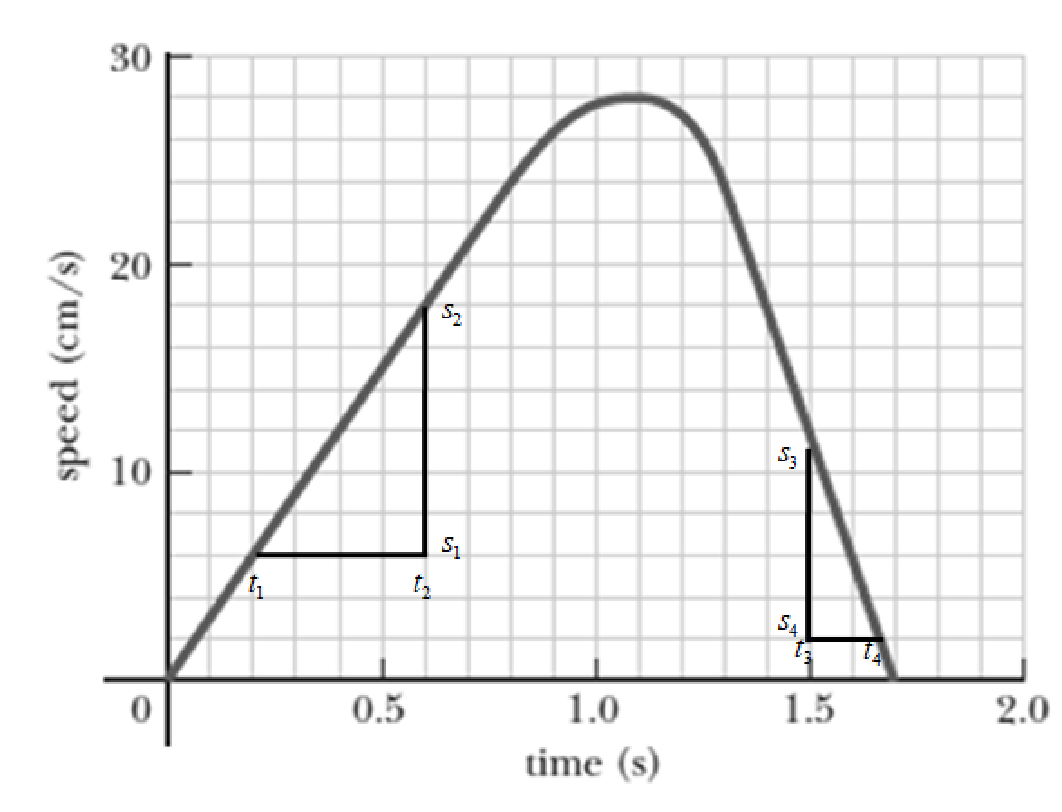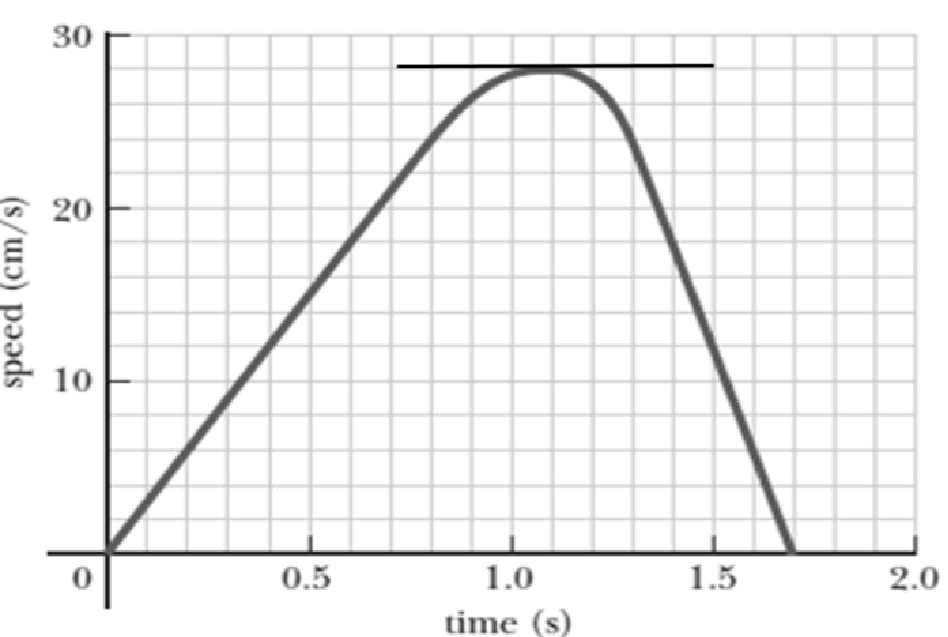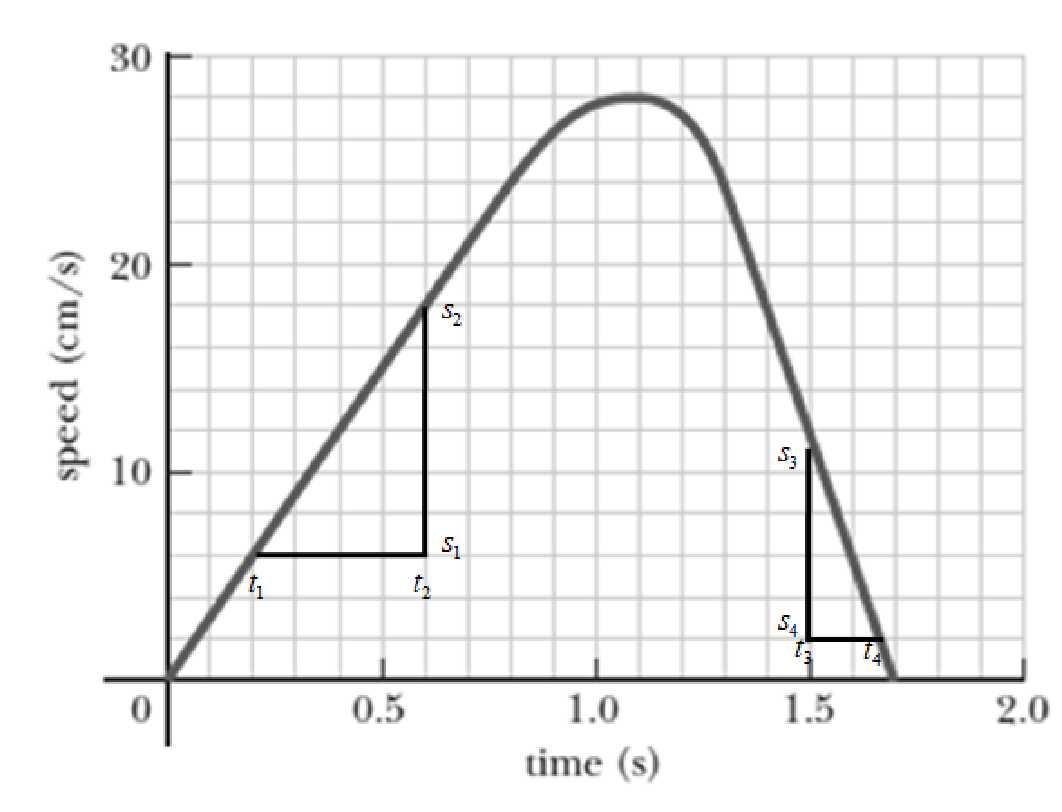
(a)
The force exerted by the chin-up bar on the person’s body at
(a)
Answer to Problem 41P
The force exerted by the chin-up bar on the person’s body at
Explanation of Solution
The slope of the speed versus time graph gives the magnitude of the acceleration. Consider positive slope of speed versus time graph as positive acceleration and negative slope of speed versus time graph gives negative acceleration. When the slope is zero the acceleration is zero.
According to Newton’s second law,
Here,
Rewrite the above equation in terms of
Write the expression to calculate the acceleration.
Here,

From the graph the slope at time
Conclusion:
Substitute
Substitute
Therefore, the force exerted by the chin-up bar on the person’s body at
(b)
The force exerted by the chin-up bar on the person’s body at
(b)
Answer to Problem 41P
The force exerted by the chin-up bar on the person’s body at
Explanation of Solution
The slope of the speed versus time graph gives the magnitude of the acceleration. The slope of the graph at 0.5 s is same as that of 0 s. That is the graph is a straight line at these moment. If the graph is a straight line, the acceleration is same.
The mass of the person does not change and the acceleration is same as that at
Conclusion:
Therefore, the force exerted by the chin-up bar on the person’s body at
(c)
The force exerted by the chin-up bar on the person’s body at
(c)
Answer to Problem 41P
The force exerted by the chin-up bar on the person’s body at
Explanation of Solution
The graph below is the speed versus time graph

From the graph it is evident that at
Conclusion:
Substitute
Therefore, the force exerted by the chin-up bar on the person’s body at
(d)
The force exerted by the chin-up bar on the person’s body at
(d)
Answer to Problem 41P
The force exerted by the chin-up bar on the person’s body at
Explanation of Solution
The graph below is the speed versus time graph.

From the graph the slope at time
Conclusion:
Substitute
Substitute
Therefore, the force exerted by the chin-up bar on the person’s body at
Want to see more full solutions like this?
Chapter 5 Solutions
Bundle: Physics for Scientists and Engineers with Modern Physics, Loose-leaf Version, 9th + WebAssign Printed Access Card, Multi-Term
- The slope of a graph of velocity, v, vs frequency, f, is equal to wavelength, l. Compare the slope of your Data Table 1 graph to the average wavelength (Ave, l) from Data Table 1 by calculating the % Difference.arrow_forwardExamine the slope of the line on the graph created using the data in Data Table 4 of Period, T2 vs L, the slope of the line is a constant containing the acceleration due to gravity, g. Using the slope of your line, determine the experimental value for g. Compare the value you determined for g from the slope of the graph to the expected value of 9.81 m/s2 by calculating the percent error.arrow_forwardFrom your examination of the graph created using the data in Data Table 4 of Period, T vs √L . What would you determine is the relationship between the period of a pendulum and the length of a pendulum?arrow_forward
- In a certain bimetallic strip, the brass strip is 0.100% longer than the steel strip at a temperature of 283°C. At what temperature do the two strips have the same length? Coefficients of linear expansion for steel α = 12.0 × 10−6 K−1 and for brass α = 19.0 × 10−6 K−1 (see Table 13.2).arrow_forwardReview Conceptual Example 2 before attempting this problem. Two slits are 0.158 mm apart. A mixture of red light (wavelength = 693 nm) and yellow-green light (wavelength = 567 nm) falls on the slits. A flat observation screen is located 2.42 m away. What is the distance on the screen between the third-order red fringe and the third-order yellow-green fringe? m = 3 m = 3 m = 0 m = 3 m = 3 Fringes on observation screenarrow_forwardA film of oil lies on wet pavement. The refractive index of the oil exceeds that of the water. The film has the minimum nonzero thickness such that it appears dark due to destructive interference when viewed in visible light with wavelength 643 nm in vacuum. Assuming that the visible spectrum extends from 380 to 750 nm, what is the longest visible wavelength (in vacuum) for which the film will appear bright due to constructive interference? Number Unitsarrow_forward
- A piece of metal is placed on top of a 2.0 - kg wooden block (mass density = 562 kg/m³) piece. UseArchimedes' principle to calculate the mass (in kg) of copper if the top of the wood surface is exactly at thewater's surface?arrow_forwardA filmmaker wants to achieve an interesting visual effect by filming a scene through a converging lens with a focal length of 50.0 m. The lens is placed betwen the camera and a horse, which canters toward the camera at a constant speed of 7.9 m/s. The camera starts rolling when the horse is 36.0 m from the lens. Find the average speed of the image of the horse (a) during the first 2.0 s after the camera starts rolling and (b) during the following 2.0 s.arrow_forwardAnswer the question (Physics)arrow_forward
 Physics for Scientists and Engineers: Foundations...PhysicsISBN:9781133939146Author:Katz, Debora M.Publisher:Cengage Learning
Physics for Scientists and Engineers: Foundations...PhysicsISBN:9781133939146Author:Katz, Debora M.Publisher:Cengage Learning Principles of Physics: A Calculus-Based TextPhysicsISBN:9781133104261Author:Raymond A. Serway, John W. JewettPublisher:Cengage Learning
Principles of Physics: A Calculus-Based TextPhysicsISBN:9781133104261Author:Raymond A. Serway, John W. JewettPublisher:Cengage Learning Glencoe Physics: Principles and Problems, Student...PhysicsISBN:9780078807213Author:Paul W. ZitzewitzPublisher:Glencoe/McGraw-Hill
Glencoe Physics: Principles and Problems, Student...PhysicsISBN:9780078807213Author:Paul W. ZitzewitzPublisher:Glencoe/McGraw-Hill Physics for Scientists and Engineers with Modern ...PhysicsISBN:9781337553292Author:Raymond A. Serway, John W. JewettPublisher:Cengage Learning
Physics for Scientists and Engineers with Modern ...PhysicsISBN:9781337553292Author:Raymond A. Serway, John W. JewettPublisher:Cengage Learning Physics for Scientists and EngineersPhysicsISBN:9781337553278Author:Raymond A. Serway, John W. JewettPublisher:Cengage Learning
Physics for Scientists and EngineersPhysicsISBN:9781337553278Author:Raymond A. Serway, John W. JewettPublisher:Cengage Learning University Physics Volume 1PhysicsISBN:9781938168277Author:William Moebs, Samuel J. Ling, Jeff SannyPublisher:OpenStax - Rice University
University Physics Volume 1PhysicsISBN:9781938168277Author:William Moebs, Samuel J. Ling, Jeff SannyPublisher:OpenStax - Rice University





